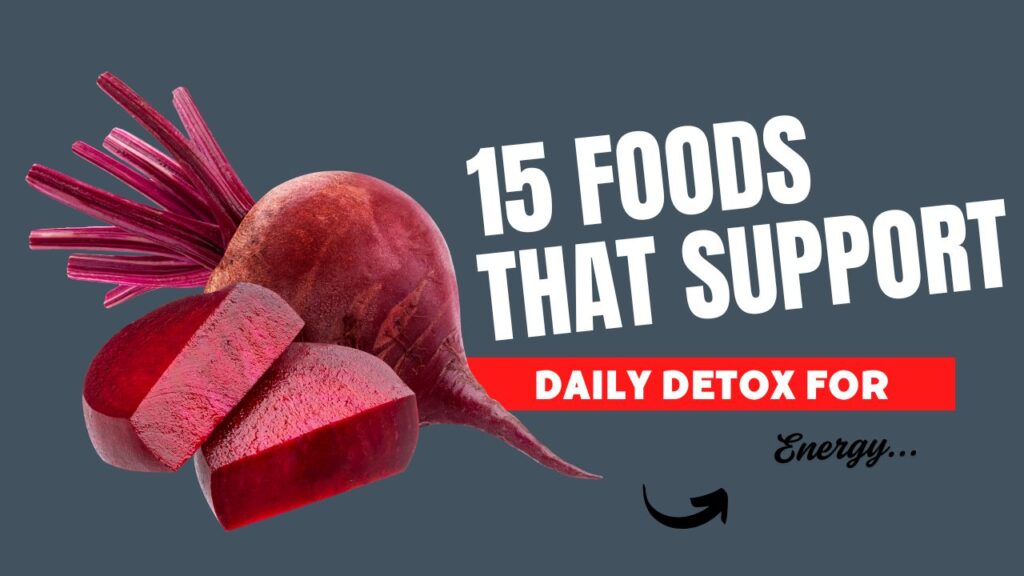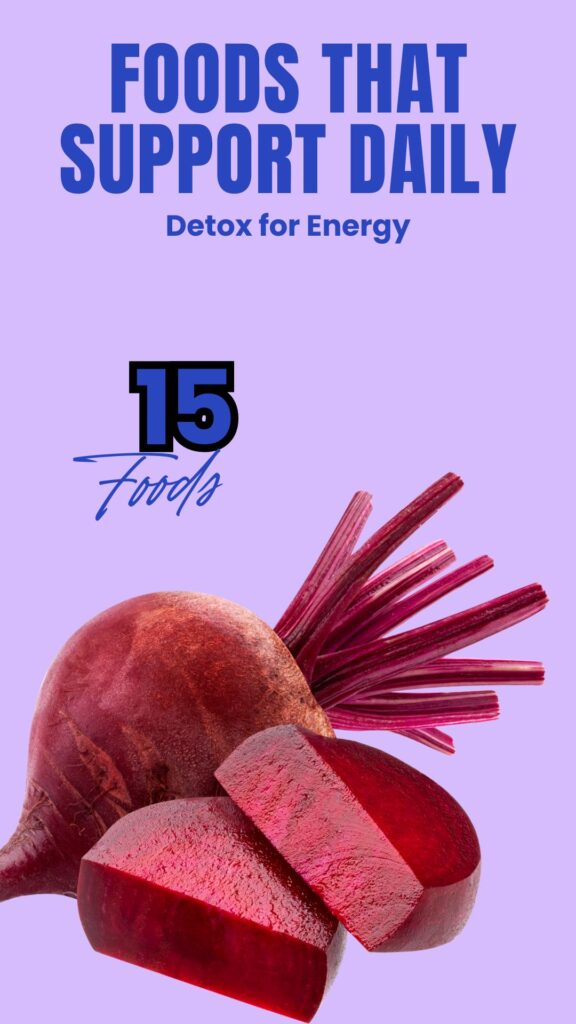Some links in this post are affiliate links. If you make a purchase through these links, I may receive a small commission. This helps support the site at no extra cost to you.
Do you often feel sluggish, tired, or drained before the day even begins? Struggling with low energy isn’t always about lack of sleep or exercise—it can also be a sign that your body needs detox support.
Daily exposure to processed foods, environmental toxins, and stress can accumulate harmful substances in your body, making you feel fatigued. But here’s the good news: certain natural foods can help your body detoxify while boosting your energy levels.
In this post, we’ll explore 15 foods that naturally support daily detox, how to incorporate them into your meals, tips to maximize their benefits, who should consume them, storage advice, possible side effects, and more.
Whether you’re an athlete, a busy professional, or someone looking to improve overall wellness, these foods can be a game-changer.
Let’s dive in!

Table of Contents

15 Foods That Help In Detox
1. Lemon
Best Ways to Eat or Use It
- Drink warm lemon water in the morning to kickstart digestion.
- Use fresh lemon juice on salads or steamed vegetables.
- Add slices to herbal teas for a refreshing detox boost.
Tip: Pair lemon with honey to soothe the stomach and enhance digestion.
Who Should Eat / Avoid
- Good for: anyone looking to improve digestion, boost immunity, and increase energy.
- Avoid/Limit if: you have acid reflux or citrus allergies.
Storage & Buying Tips
- Select firm, bright yellow lemons without soft spots.
- Store in the fridge for up to 2–3 weeks to maintain freshness.
Do’s & Don’ts
| ✅ Do | ❌ Don’t |
|---|---|
| Drink warm lemon water in the morning | Rely only on lemon for detox |
| Use in moderation to avoid acidity | Store lemons at room temperature too long |
Possible Side Effects
- Excessive consumption may cause enamel erosion or heartburn.
2. Beetroot
Best Ways to Eat or Use It
- Raw in salads or as juice.
- Roasted or steamed as a side dish.
- Added to smoothies with carrots and ginger.
Interesting Fact: Beets are rich in nitrates, which may improve blood flow and energy levels.
Who Should Eat / Avoid
- Good for: athletes, people with high blood pressure, anyone needing a natural energy boost.
- Avoid/Limit if: prone to kidney stones (high oxalate content).
Storage & Buying Tips
- Choose firm beets with smooth skin and minimal blemishes.
- Store in a cool, dark place or fridge for up to 2 weeks.
Do’s & Don’ts
| ✅ Do | ❌ Don’t |
|---|---|
| Roast or steam to retain nutrients | Boil excessively; nutrients may leach into water |
| Pair with citrus for better iron absorption | Ignore portion control—high sugar content |
Possible Side Effects
- May cause pink-colored urine or stools (harmless).
3. Spinach
Best Ways to Eat or Use It
- Raw in salads or smoothies.
- Lightly sautéed with olive oil.
- Added to soups and stews.
Tip: Pair with vitamin C-rich foods (like bell peppers) to enhance iron absorption.
Who Should Eat / Avoid
- Good for: vegetarians, pregnant women, athletes.
- Avoid/Limit if: prone to kidney stones.
Storage & Buying Tips
- Choose bright green, crisp leaves.
- Wash thoroughly and store in a sealed container in the fridge.
Do’s & Don’ts
| ✅ Do | ❌ Don’t |
|---|---|
| Use fresh in salads | Cook too long; loses nutrients |
| Mix with healthy fats | Store wet leaves; can spoil quickly |
Possible Side Effects
- Excessive consumption may contribute to kidney stone formation in susceptible individuals.
4. Ginger
Best Ways to Eat or Use It
- Fresh ginger in teas or infused in hot water.
- Grated into stir-fries or smoothies.
- Added to salad dressings or marinades.
Myth Buster: Ginger doesn’t “burn fat” instantly but supports digestion and metabolism, indirectly aiding energy.
Who Should Eat / Avoid
- Good for: people with digestive issues, morning sickness, or inflammation.
- Avoid/Limit if: prone to bleeding disorders or taking blood-thinning medication.
Storage & Buying Tips
- Firm, smooth ginger with no wrinkles is freshest.
- Refrigerate or freeze slices to extend shelf life.
Do’s & Don’ts
| ✅ Do | ❌ Don’t |
|---|---|
| Use fresh for maximum potency | Overconsume; can cause heartburn |
| Add to hot water for tea | Rely solely on ginger for energy |
Possible Side Effects
- May cause mild heartburn or stomach upset if consumed excessively.
5. Green Tea
Best Ways to Eat or Use It
- Steep in hot water for 2–3 minutes to make tea.
- Use as a base for smoothies.
- Pair with lemon for added detox benefits.
Interesting Fact: Green tea contains catechins, antioxidants that support liver detoxification and boost metabolism.
Who Should Eat / Avoid
- Good for: adults seeking natural energy, weight management, and antioxidant support.
- Avoid/Limit if: sensitive to caffeine or pregnant women should limit intake.
Storage & Buying Tips
- Store in a dark, airtight container.
- Avoid moisture to prevent spoilage.
Do’s & Don’ts
| ✅ Do | ❌ Don’t |
|---|---|
| Steep for short periods | Boil leaves for long; can taste bitter |
| Drink in moderation | Add too much sugar; reduces benefits |
Possible Side Effects
- Excess caffeine may cause insomnia, jitteriness, or upset stomach.
6. Turmeric
Best Ways to Eat or Use It
- Add to curries, soups, or rice dishes.
- Make golden milk with warm milk and honey.
- Use in smoothies with black pepper for absorption.
Tip: Piperine (from black pepper) enhances turmeric’s absorption.
Who Should Eat / Avoid
- Good for: anti-inflammatory support, liver health, and general detox.
- Avoid/Limit if: gallbladder issues or prone to kidney stones.
Storage & Buying Tips
- Store in airtight jars away from sunlight.
- Use fresh turmeric roots when possible.
Do’s & Don’ts
| ✅ Do | ❌ Don’t |
|---|---|
| Combine with black pepper | Overuse high doses without guidance |
| Use in both food and drinks | Rely only on turmeric for detox |
Possible Side Effects
- High doses may cause digestive upset.
7. Garlic
Best Ways to Eat or Use It
- Raw in salads or dressings for maximum allicin.
- Cook lightly in stir-fries or soups.
- Roast for milder flavor and antioxidant benefits.
Interesting Fact: Garlic supports liver detoxification enzymes and boosts immune function.
Who Should Eat / Avoid
- Good for: heart health, immunity, and natural detox.
- Avoid/Limit if: taking blood thinners or have digestive sensitivity.
Storage & Buying Tips
- Firm, dry bulbs without sprouting are best.
- Store in a cool, dark, ventilated place.
Do’s & Don’ts
| ✅ Do | ❌ Don’t |
|---|---|
| Crush or chop before cooking | Cook excessively; reduces active compounds |
| Add to meals regularly | Consume excessively raw; can irritate stomach |
Possible Side Effects
- May cause bad breath or mild digestive upset.
8. Avocado
Best Ways to Eat or Use It
- Sliced in salads or on toast.
- Blended into smoothies for creamy texture.
- Mashed as a healthy dip or spread.
Tip: Healthy fats in avocado help absorb fat-soluble vitamins from other detox foods.
Who Should Eat / Avoid
- Good for: anyone needing heart-healthy fats, energy, and fiber.
- Avoid/Limit if: allergic to avocados or prone to high-calorie intake.
Storage & Buying Tips
- Choose slightly firm fruit; ripen at room temperature.
- Store in the fridge once ripe to extend shelf life.
Do’s & Don’ts
| ✅ Do | ❌ Don’t |
|---|---|
| Eat ripe and fresh | Store unripe in fridge |
| Combine with salads | Overconsume; high in calories |
Possible Side Effects
- May cause mild digestive discomfort if overeaten.
9. Broccoli
Best Ways to Eat or Use It
- Lightly steam to preserve nutrients and crunch.
- Roast with olive oil and garlic for a flavorful side dish.
- Add raw florets to salads or green smoothies.
Interesting Fact: Broccoli is rich in sulforaphane, a compound known to support liver detoxification and fight inflammation.
Who Should Eat / Avoid
- Good for: everyone, especially those looking to support immunity, heart, and liver health.
- Avoid/Limit if: prone to gas or digestive discomfort from cruciferous vegetables.
Storage & Buying Tips
- Choose firm, dark green florets with tight buds.
- Store in a perforated plastic bag in the fridge for up to 5–7 days.
Do’s & Don’ts
| ✅ Do | ❌ Don’t |
|---|---|
| Steam lightly to retain nutrients | Overcook; reduces vitamin content |
| Pair with lemon or olive oil | Store at room temperature too long |
Possible Side Effects
- Excessive consumption may cause bloating or gas in sensitive individuals.
10. Blueberries
Best Ways to Eat or Use It
- Enjoy raw as a snack or in breakfast bowls.
- Blend into smoothies for natural sweetness and antioxidants.
- Mix into oatmeal or yogurt for added fiber.
Interesting Fact: Blueberries are among the richest sources of antioxidants, which help combat oxidative stress and support detox pathways.
Who Should Eat / Avoid
- Good for: anyone, particularly those seeking cognitive support, energy, and heart health.
- Avoid/Limit if: you have allergies to berries (rare) or need to monitor sugar intake.
Storage & Buying Tips
- Select firm, plump berries with a deep blue color.
- Store in the fridge; wash only before eating to prevent mold.
Do’s & Don’ts
| ✅ Do | ❌ Don’t |
|---|---|
| Eat fresh or frozen | Keep wet; promotes mold growth |
| Add to cereals or smoothies | Rely solely on blueberries for antioxidants |
Possible Side Effects
- Excessive intake may lead to mild digestive discomfort due to fiber.
11. Almonds
Best Ways to Eat or Use It
- Raw or roasted as a snack.
- Add to oatmeal, yogurt, or smoothies.
- Use almond butter as a healthy spread.
Tip: Almonds are rich in vitamin E and healthy fats, supporting cellular detoxification and energy production.
Who Should Eat / Avoid
- Good for: anyone needing energy, brain support, or heart-healthy fats.
- Avoid/Limit if: allergic to nuts or prone to excess calorie intake.
Storage & Buying Tips
- Buy unsalted, raw almonds for best health benefits.
- Store in an airtight container in a cool, dark place or fridge to extend shelf life.
Do’s & Don’ts
| ✅ Do | ❌ Don’t |
|---|---|
| Soak overnight for easier digestion | Overeat; high in calories |
| Include in breakfast or snacks | Buy salted/roasted versions excessively |
Possible Side Effects
- May cause digestive discomfort if eaten in very large amounts.
12. Carrots
Best Ways to Eat or Use It
- Raw as a snack or in salads.
- Steamed or roasted to retain natural sweetness.
- Blend into smoothies or soups.
Interesting Fact: Carrots are rich in beta-carotene, which supports liver health and skin detoxification.
Who Should Eat / Avoid
- Good for: children, adults, pregnant women, and anyone seeking eye health and liver support.
- Avoid/Limit if: prone to high blood sugar (moderate intake recommended).
Storage & Buying Tips
- Select firm, vibrant orange carrots without cracks or soft spots.
- Store in the fridge in a perforated bag for up to 2–3 weeks.
Do’s & Don’ts
| ✅ Do | ❌ Don’t |
|---|---|
| Eat raw or lightly cooked | Overcook; reduces nutrients |
| Pair with healthy fats | Store unwashed too long; can spoil |
Possible Side Effects
- Overconsumption may cause mild skin discoloration (carotenemia), which is harmless.
13. Cucumber
Best Ways to Eat or Use It
- Sliced raw in salads or sandwiches.
- Blend into detox smoothies or juices.
- Serve as a refreshing snack with hummus or yogurt dip.
Tip: The high water content helps flush out toxins and keep the body hydrated.
Who Should Eat / Avoid
- Good for: anyone looking to stay hydrated, support kidney function, or boost energy naturally.
- Avoid/Limit if: prone to digestive discomfort from raw vegetables.
Storage & Buying Tips
- Choose firm cucumbers with smooth, dark green skin.
- Store in the fridge for up to 1 week.
Do’s & Don’ts
| ✅ Do | ❌ Don’t |
|---|---|
| Peel if skin is waxed | Store at room temperature too long |
| Eat raw for maximum hydration | Overcook; loses water content |
Possible Side Effects
- Excessive consumption may cause mild bloating in sensitive individuals.
14. Apples
Best Ways to Eat or Use It
- Eat raw as a quick snack.
- Slice into oatmeal, salads, or yogurt.
- Bake or stew with cinnamon for a natural dessert.
Myth Buster: “An apple a day keeps the doctor away” isn’t just a saying—apples are high in fiber and antioxidants, supporting gut health and toxin elimination.
Who Should Eat / Avoid
- Good for: everyone, especially weight-loss seekers and digestive health enthusiasts.
- Avoid/Limit if: sensitive to fructose or on a low-sugar diet.
Storage & Buying Tips
- Choose firm, unbruised apples.
- Store in the fridge for up to 4 weeks; separate from bananas to prevent rapid ripening.
Do’s & Don’ts
| ✅ Do | ❌ Don’t |
|---|---|
| Eat with skin for maximum fiber | Overeat; high in sugar |
| Pair with nut butter for balanced snack | Store bruised apples |
Possible Side Effects
- Excessive intake may cause mild digestive upset due to fiber.
15. Chia Seeds
Best Ways to Eat or Use It
- Mix into smoothies, oatmeal, or yogurt.
- Make chia pudding by soaking in almond or coconut milk.
- Sprinkle on salads or baked goods for extra fiber.
Interesting Fact: Chia seeds expand when soaked, forming a gel that supports digestion, blood sugar control, and natural detoxification.
Who Should Eat / Avoid
- Good for: athletes, weight-loss seekers, and digestive health enthusiasts.
- Avoid/Limit if: prone to digestive obstruction or swallowing difficulties.
Storage & Buying Tips
- Buy whole, raw chia seeds.
- Store in an airtight container in a cool, dark place to maintain freshness.
Do’s & Don’ts
| ✅ Do | ❌ Don’t |
|---|---|
| Soak before eating | Eat dry in large amounts |
| Add to meals gradually | Overconsume; can cause bloating |
Possible Side Effects
- May cause mild digestive discomfort if eaten in excess without proper hydration.
Conclusion
Adding these 15 detox-friendly foods to your daily diet can naturally enhance energy, support liver and kidney function, improve digestion, and provide essential antioxidants.
From leafy greens and vibrant berries to nutrient-rich nuts and seeds, these foods offer a delicious, easy way to support your body’s natural detoxification pathways.
Start small: add lemon to your morning water, include garlic or ginger in meals, enjoy a handful of almonds, and blend a smoothie with spinach, beetroot, and chia seeds. Over time, these habits can boost energy levels, improve focus, and enhance overall vitality.
Frequently Asked Questions (FAQs)
What does “detox” really mean?
Detox refers to the natural process by which your body removes toxins through the liver, kidneys, digestive system, skin, and lungs. Eating detox-supportive foods helps these organs function optimally.
Can these foods give instant energy?
While they won’t act like caffeine, these foods support digestion, improve nutrient absorption, and reduce fatigue over time, leading to more consistent energy throughout the day.
How many of these foods should I eat daily?
Aim to include a variety of 3–5 foods from this list in your daily diet. Portion sizes depend on the food type; for example, a handful of nuts, 1–2 servings of fruits, and 1–2 cups of vegetables is a good start.
Are detox foods safe for everyone?
Most of these foods are safe for the general population. However, people with allergies, digestive issues, kidney problems, or certain medical conditions should check with a healthcare provider before significantly increasing intake.
Can I combine these foods together?
Yes! Many combinations, like spinach + lemon, or beetroot + ginger, enhance nutrient absorption and maximize detox benefits. Just be mindful of personal tolerance and portion sizes.
How long does it take to feel benefits from these foods?
Some effects, like improved digestion and hydration, may be noticed within a few days. More noticeable energy boosts and detox support typically appear within 2–4 weeks of consistent consumption.
Can I use supplements instead of these foods?
Whole foods provide fiber, antioxidants, and phytonutrients that supplements can’t fully replicate. Supplements may help in certain cases, but eating the actual foods is the most effective and natural approach.
Do I need to follow a strict detox diet with these foods?
No strict rules are necessary. Simply including these foods regularly in balanced meals supports your body’s natural detox pathways without extreme restrictions.
Can kids eat these detox foods?
Yes! Most of these foods are safe for children. Adjust portions and preparation methods (like steaming vegetables) to suit younger age groups.
Should I avoid anything while eating these detox foods?
It’s helpful to limit processed foods, excess sugar, alcohol, and highly fried foods, as they can introduce more toxins and reduce the effectiveness of detox-supportive foods.










